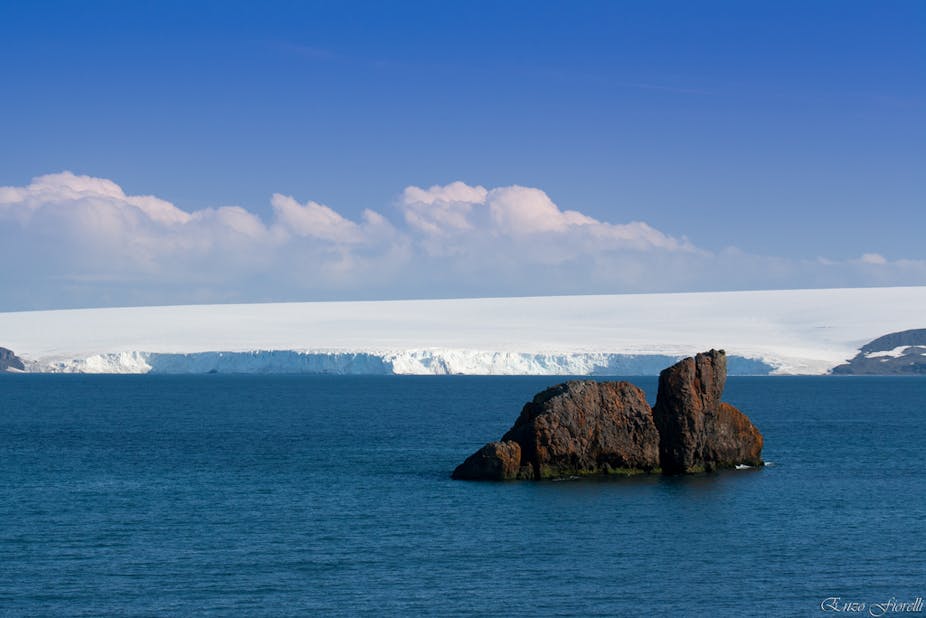Ocean acidification is often referred to as the “evil twin” of climate change.
Greenhouse gasses are doing more than just warming the globe. Increasing C0₂ levels are also changing the chemical make-up of our oceans.
What is the ocean’s role is absorbing CO₂?
We live on the blue planet. With nearly three-quarters of the Earth covered in ocean it is not surprising that it plays a crucial role in capturing CO₂.
Currently, approximately half the CO₂ we emit stays in the atmosphere, a quarter is absorbed by the biosphere (plants and soils) and a quarter is absorbed by the ocean. The set of chemical processes that occurs when CO₂ is absorbed in seawater is known as “ocean acidification”.
The current concentration of CO₂ in our planet’s atmosphere (more than 390 parts per million) is higher than has been experienced on Earth for hundreds of thousands of years. The rate of increase of atmospheric CO₂ since the industrial revolution – driven by human fossil fuel combustion and deforestation – is faster than has occurred for millions of years.
Because of the amount of CO₂ absorbed by the oceans, this increase in emissions is changing the acidity and therefore the chemistry of our oceans.
Ocean acidification 101 – the chemistry
When carbon dioxide dissolves in seawater it forms a weak acid – carbonic acid – that rapidly releases a bicarbonate ion and hydrogen ion.
Some of the excess hydrogen ions seek out carbonate ions to make even more bicarbonate. This decreases the availability of carbonate ions otherwise available to shell-forming and skeleton-building organisms. The remaining free hydrogen ions lower the ocean’s pH, that is, make it more acidic.
While these chemical processes are well understood and scientifically validated, our understanding of how this will impact on shell-forming and skeleton-building organisms – known as calcifiers – and its implications for whole ocean ecosystems is in its infancy.
We do know that we are likely to see the impact of ocean acidification in our coldest waters first. This is because CO₂ is more soluble in cold water – the principle that sees an open bottle of champagne keep its fizz longer in the fridge than at room temperature – so we are particularly concerned that our polar oceans will bear the heaviest burden of ocean acidification.
Why is this a serious issue?
Modelling based on a continuation of the current emissions scenario projects that by 2054, 50% of the Arctic Ocean will have crossed a chemical threshold known as aragonite undersaturation.
This is the point at which the most fragile of shell-makers – those that use aragonite, the most soluble form of calcium carbonate – can no longer make their shells as they do today.
“Business as usual” modelling also projects that the entire Southern Ocean will become undersaturated in aragonite by 2100, and as early as 2030 in some parts.
These projections have implications for the rich communities of calcifiers, including foraminifera and the aragonitic pteropods and cold-water corals (below), which are a significant component of high-latitude ocean ecosystems.

Researchers at the Antarctic Climate & Ecosystems Cooperative Research Centre have found that natural populations of foraminifera (single celled shelled zooplankton) in the Southern Ocean are already 30 to 35% lighter than their pre-industrial counterparts.
Additionally, populations of some species of pteropod (shelled planktonic molluscs more poetically known as “sea butterflies”) appear to be declining in monitoring traps in the Sub-Antarctic Southern Ocean.
As foraminifera and pteropods are integral to polar and sub-polar food webs (pteropods alone account for up to 45% of the diet of Alaskan pink salmon) we have increasing concern for their health and longevity in a high CO₂ ocean.
Ultimately, impacts on polar calcifiers will have impacts on higher levels of the food chain and across latitudinal boundaries. Polar calcifiers are important food sources for marine predators including salmon, mackerel, herring, cod and baleen whales in the Arctic, and krill, fur seals, Adelie penguins and whales in the Antarctic.
The loss or reduction in habitat of these “potato chips of the sea” are likely to have serious consequences for the wider ocean community.
Perhaps closer to most people’s hearts (or stomachs) are the likely impacts of ocean acidification on fish. Some of the richest and most heavily exploited fishing areas in the world are located in high-latitude seas.
More than half the total current US fishery landings – a $4-billion-per-year industry – are derived from Alaskan waters. The Southern Ocean currently supports krill and Patagonian toothfish fisheries. Under current global emission scenarios, ocean acidification is likely to severely affect the waters that support these industries before the end of the century.
Our oceans matter
As the custodians of this blue planet we must be mindful of the role the ocean plays in mitigating climate change. We must understand that ocean ecosystems are important to us economically, socially and environmentally.
Scientists in this field are now taking the steps to determine the impacts of continuing ocean acidification on these ecosystems.

